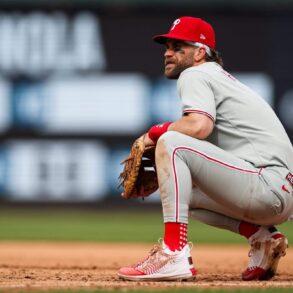NEW YORK — The Torpedo Bat Era isn’t even a week old.
But in the short time since Yankees play-by-play man Michael Kay pointed out the team’s new, misshapen sticks on live TV, Torpedo Bat Mania has consumed the baseball world. Clubhouses, press boxes, bleachers and broadcasts are abuzz with questions and curiosities about these novel, bowling-pin-shaped pieces of lumber.
Advertisement
Meanwhile, the conversation has crossed over into the public consciousness to a significant degree. Michael Strahan did a segment about it on “Good Morning America.” Movie star and Dodgers fan O’Shea Jackson Jr. tweeted about it. And perhaps most bizarrely, the account for the Assassin’s Creed video game series posted a joke about a torpedo-shaped katana sword.
Within the game, however, there is exhaustion.
Reporters, evaluators, coaches and, in particular, players have already grown quite sick of this plot line. Any inquiry about the bats effectively begins with an apology: “Sorry to ask about the torpedoes again, but …”
Advertisement
That’s because these insiders see this whole craze as little more than a passing, overblown fad.
Asked whether he was surprised by the discourse around torpedo bats, injured Yankees slugger Giancarlo Stanton replied, “Yeah, but when there’s a narrative, that’s how it rolls.”
Eye rolls aside, this story is far from insignificant. Beneath the baseless grumbling about the Yankees cheating and the memes about oversized wiffle-ball bats, there’s something real going on here. Something relatively revealing. Torpedo bats might be a passing trend, sure, but the Yankees pumped resources, time and energy into developing this new technology for a reason.
Advertisement
Quite simply, the advent of custom bat engineering offers a fascinating window into how modern baseball functions and why the Yankees, despite their secret getting out, still maintain a significant competitive advantage.
Innovation, or at least the pursuit of it, is never-ending. After a century of relative stasis, the Moneyball Era and ensuing technological revolution have morphed into an unstoppable freight train. The unyielding quest for untapped value has seeped into every corner of MLB, from player acquisition to player development to, now, player equipment. Peculiar as these bats might look, this is, at the heart of it, a natural outcome.
Teams are thirsty for an edge and will look for one in every nook and cranny.
Torpedo bats are sweeping through baseball, but the Yankees still maintain a notable edge in the innovation. (Mallory Bielecki/Yahoo Sports illustration)
(Mallory Bielecki/Yahoo Sports)
But the Yankees, who popularized the bats last weekend via an offensive obliteration of the Milwaukee Brewers, weren’t the only team whittling away behind the scenes. Aaron Leanhardt, a former MIT physicist, former Yankees minor-league coach and current Marlins field coordinator, has been identified as the godfather of torpedo bats. But as “Lenny” was cooking up his design, other big-brained baseball people were on the hunt as well.
Advertisement
Orioles color commentator Ben McDonald mentioned on Wednesday’s broadcast the Baltimore organization had been tinkering with custom bats for a while. Sources around MLB confirmed as much to Yahoo Sports. O’s catcher Adley Rutschman fully embraced the torpedo bat during spring training after the idea was proposed to Orioles players last year by Sig Mejdal, an assistant general manager and head of Baltimore’s analytics department.
For both organizations, this secret getting out is likely seen as an unfortunate result. Yankees brass can’t be enthused that Kay blew up their spot on the broadcast. But while the opening of this can of worms was sudden and explosive, the idea of custom bat crafting had already begun to permeate the game. In order to get these bats made, Mejdal and Leanhardt had to pursue collaborations with bat makers. Once those manufacturers were let in on the idea, the information was out there, and its dissemination was inevitable.
This is the case for any trend in baseball. A team uncovers something interesting. It implements it in a game to a degree of success. Smart people from other teams notice the change in approach and the results and try to reverse-engineer the idea. That process is only sped up by staff and players moving among teams. Meaningful innovation ideated covertly and implemented successfully will, in time, be uncovered by either the public or by other teams through natural cross-organizational flow. In other words: If you have good ideas, ideas that work, other people will eventually learn about them.
But while 28 clubs besides New York and Baltimore now, at the very least, have “Torpedo Bats” written on a to-do list somewhere, the Yankees and Orioles do maintain a notable advantage, even if their concept, once proprietary, is now public.
Advertisement
“There’s a lot more to it than just, ‘I’ll take that torpedo on the shelf over there,’” Yankees manager Aaron Boone said at a recent news conference. “Our guys are way more invested in it than that. It’s really personalized. They really work with our players in creating this stuff.”
Usage of the bat around the league has predictably spiked in the wake of New York’s home run barrage. Mets slugger Pete Alonso, for instance, told reporters he put in an order for torpedo bats. But whether Alonso’s swing, batted-ball data and biomechanical profile are a good fit for the torpedo bat is unclear, as is how tailored said bats will be to his exact specifications. The Yankees and Orioles have, presumably, already collected that information and made recommendations to certain players about specific bat choices.
For the rest of the league, at this point, the process seems more like guesswork than science, more like buying off the rack than tailoring.
One high-ranking front-office person from an NL team told Yahoo Sports there’s belief most teams would begin researching optimized bat design — with one caveat.
“How easily accessible they are [for the other teams], how customizable they are, how research-backed they are, I think remains to be seen.”
This post was originally published on this site be sure to check out more of their content.






